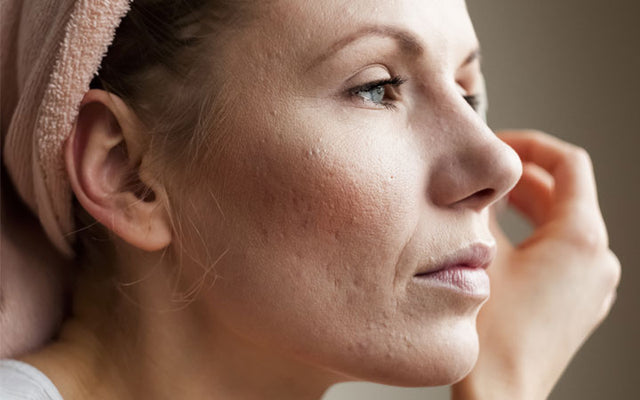Have the years of acne breakouts led to tiny holes on your skin? These are called pockmarks, which can be caused due to infections or diseases like chickenpox as well.
Pockmarks on the face may mess with your self esteem, but remember to celebrate yourself, no matter what. There are also several treatment options you can try if you want to reduce the appearance of pockmarks. Read on for all the details.
Highlights:
What Are Pockmarks On The Face?
When the underlying, deeper layers of the skin below the epidermis get damaged, they can lead to pockmarks. These are sunken or concave shaped scars, and resemble dents or holes formed in the skin. They are also referred to as acne scars or pick marks.
Pockmarks are noticeable because they look visibly different from the rest of the skin and give it an uneven texture. When the deeper, damaged layers of the skin start to heal, the cells produce extra collagen, which may leave behind scar tissue. This scar tissue looks different from the tissues on the rest of your skin.
What Causes Pockmarks On The Face?
1. Acne
A leading cause for pockmarks is acne. Starting from the teenage years and puberty, acne can happen to men and women of all ages. Acne is caused due to the production of excessive sebum, which leads to clogged pores and pimples.
If your acne is chronic and acute, and if you have the habit of popping pimples, both of these reasons can lead to pockmarks [1]. Even healing the acne with medication or topical formulations can lead to pockmarks after the acne has subsided.
2. Bacterial Infections
At times, infections caused by bacteria [2] such as streptococcus or staphylococcus are also known to lead to pimples. If they infect a hair follicle, it can cause boils. A cut caused by a razor or a sharp object can also get infected and lead to pockmarks. Blisters too can be a cause.
3. Infectious Diseases
One of the most prominent causes of pockmarks have been ailments like chickenpox and smallpox. Smallpox [3] leaves characteristic oval shaped pockmarks but the disease has been more or less eradicated from the planet.
Chickenpox [4], however, is still known to occur and can happen at any age. It is characterised by blisters that are very itchy and form scabs. If you scratch on the scabs before they fall off on their own, they can leave pockmarks.
How To Treat Pockmarks?
While no treatment may give a 100% guarantee of removing pockmarks completely, there are a few treatment options available. All of them need professional advice and treatments should be taken based on your skin type and its levels of tolerance. Details of each are mentioned below:
1. Treatment Creams
These OTC creams work to minimise the appearance of scars and can be used without a prescription. They must be used regularly and take much longer to show results compared to other treatment options. Sometimes, they also cause side effects like irritated skin and rash.
Most people opt for OTC treatments as the first option to treat pockmarks. They hydrate the skin and may reduce itching. But, because the chemicals present may cause side effects, if you are planning on long term use, it is better to do so with advice from a dermatologist.
2. Facial Massage
Getting a massage done on your face may not remove scars on its own. But it can be a supportive therapy to other scar removal methods. It improves blood circulation, drains the toxins out and reduces inflammation, leading to an improvement in the texture of your skin.
There is no research that proves a link between a massage and reduction of pockmarks. But a regular facial massage will provide the usual benefits of a massage - that is reduction in inflammation and stress levels.
You can opt for a massage done manually or a massage wand. Both methods are beneficial and have no side effects.
3. Chemical Peel Treatments
This is a popular treatment option to reduce the appearance of pockmarks on the face. In a chemical peel treatment, the skin is covered with an acid or an enzyme. The acids used for a chemical peel function as strong exfoliators.
Ingredients used in chemical peels include glycolic acid, alpha hydroxy acid, salicylic acid, trichloroacetic acid [TCA] and pyruvic acid. Chemical peels remove damaged cells by seeping into the epidermis and the middle layers of the skin, leading to new cells [5].
When new skin is regenerated, it can have fewer visible pockmarks. It also leads to a more even tone and smoother skin texture.
This treatment needs to be done regularly for best results. It has side effects like redness, peeling, and a burning sensation or irritation. Your dermatologist will recommend the frequency of treatment depending on your skin’s sensitivity and the ingredients being used.
4. Dermabrasion
This method of removing pockmarks is a chemical free option to achieve results similar to those achieved by using chemical peels. Here, the professional will use a sanding machine or a small wire brush that is rotated over the skin to remove its top layers.
Dermabrasion [6] is usually done after administering local or general anaesthesia. The doctor decides that based on how large or small the area needing treatment is. Nothing is applied after the treatment as the skin heals on its own and results in a more even toned skin.
However, the removal of the epidermis and the layer immediately below it, may cause side effects such as infections, enlarged pores, new scars and even an uneven skin colour. Dermabrasion is more effective for scars that are not very deep.
5. Microdermabrasion
Slightly different from dermabrasion, microdermabrasion [7] removes the top layers of the skin to reduce the appearance of pockmarks. Minute crystals of aluminium oxide or bicarbonate are used to remove the top layers and this treatment is most effective for smaller scars.
It usually needs several sittings and is best done by a dermatologist, though there are DIY kits available. Unlike other treatments, microdermabrasion doesn’t have side effects but needs regular sessions for best results.
6. Ablative Laser Resurfacing
One of the most invasive treatments for pockmarks, ablative laser resurfacing [8] uses a laser beam to remove several layers of the skin. It removes the thinner layers of the skin on pockmarks. The results are known to last for years and you won’t need additional treatments for pockmarks.
Ablative laser surfacing typically needs a week or two to recover. It also involves risks like redness, swelling, acne, or change in skin tone. It is also known to worsen the scars and lead to infections in some cases.
7. Non-ablative Laser Resurfacing
Non-ablative laser resurfacing [9] works to minimise pockmarks by stimulating the skin to increase collagen production. Its results take longer to show and don’t last as long as ablative laser resurfacing. It doesn’t need as much time for healing and recovery either.
This laser therapy too comes with possible side effects like dark spots if you are dark skinned, redness, blisters and possibly new scars.
8. Dermal Fillers
Dermal fillers [10] can be used to treat pockmarks. Here, a filler like hyaluronic acid or calcium hydroxylapatite will be injected into the pockmark. These injections will fill up the pockmarks to raise them and give you an even skin texture.
Dermal fillers however, are not a permanent solution. The effects of using a dermal filler are visible from a few months to a year. Some dermal fillers have fat-based ingredients or collagen to fill the pockmarks and reduce their appearance.
A product known as Bellafill, which is approved by the USFDA only to treat acne scars contains polymethyl methacrylate [PMMA]. It has a collagen base and is in the form of very small microspheres. The results of using Bellafill are known to be visible for upto five years.
The American Association of Dermatologists states that based on the filler used, the effects of using dermal fillers can be visible from six months to several years [11].
Dermal fillers too can cause side effects like allergic reactions, infections on the skin and irritated or itchy skin.
9. Fractional Laser
This therapy is different from the others. Fractional laser therapy [12] directs a laser beam on the pockmarks and scar tissue. The laser burns out the topmost layer of the skin and promotes the growth of new skin cells. This cell regeneration makes the pockmarks less prominent.
10. Punch Excision
Punch excision [13] has no side effects and needs to be done only once. The dermatologist uses a punch -- a tool that is bigger than the scars. It removes the pockmark completely, but there will be a scar, less prominent than the pockmark, left on the surface of your skin.
11. Microneedling
Microneedling [14] is a treatment wherein pinpricks are made with tiny needles on the pockmarks. It works on the premise that as the wounds caused by the needles heal, your skin will produce more collagen to heal the punctures, leading to the pockmarks getting filled up.
Microneedling is also known as needling or collagen induction therapy. It needs follow up sessions in the span of two to six weeks for best results. Substantive results can be seen within a span of 9-12 months from the start of the treatment.
Microneedling has side effects such as infections, swelling and bruises.
12. Home Remedies
If you wish to add to any of the professional treatments with some home remedies to get rid of pockmarks, you can use moisturising and essential oils to help reduce their appearance.
- Some oils have moisturising properties and may help reduce pockmarks and scars. Some of them contain wound healing properties and others, antioxidants that decrease scar tissue.
- The best way to use natural oils or butters is to use them as moisturisers on clean skin.
- If you have oily or sensitive skin, you need to do a patch test, so that it doesn’t cause acne and more scarring.
- Some of the oils and butters that you can use to reduce the appearance of pockmarks include olive, hempseed, jojoba and rosehip seed oil.
- Butters like cocoa and shea butter may also be used as a home remedy.
- You can add 2-3 drops of lavender essential oil to the oils mentioned above to enhance wound healing and scar reduction.
- According to research, lavender essential oil has anti-inflammatory and antibacterial qualities [15] that may help reduce inflammation, bacterial infections, scars and pockmarks.
Note :
You must do a patch test on a small part of your skin to test for allergies before using any of the oils.
Do Pockmarks Fade Over Time?
Pockmarks that are deep may not fade over time on their own and may need treatment to remove or reduce their appearance. Acne scars and pits can reduce over time, even without any treatment. Discoloured scars may also fade on their own over time.
Do Pockmarks Get Worse With Age?
Yes, unfortunately, as you age, your skin loses its elasticity and collagen production also goes down. Loose skin makes the pockmarks appear more prominent with age.
Are Pockmarks Permanent?
Pockmarks are not known to vanish on their own. They need treatment to minimise their appearance on the skin or to be removed completely. So yes, if not corrected with any of the treatments mentioned above, pockmarks are permanent.
Wrapping Up
Pockmarks on the face are caused by acne and other bacterial infections. There are several remedial measures available to reduce their appearance on the skin. Most of them need a professional to do them and require several sittings.
1. https://kidshealth.org/en/teens/acne-scars.html
2. https://dermnetnz.org/topics/bacterial-skin-infections
3. https://www.cdc.gov/smallpox/about/index.html
4. https://www.cdc.gov/chickenpox/about/index.html
5. https://www.asds.net/skin-experts/skin-treatments/chemical-peels
6. https://www.plasticsurgery.org/cosmetic-procedures/dermabrasion
7. https://www.plasticsurgery.org/cosmetic-procedures/microdermabrasion
8. https://www.ucsfhealth.org/treatments/ablative-laser-resurfacing
9. https://www.asds.net/skin-experts/skin-treatments/non-ablative-laser-rejuvenation
11. https://www.aad.org/public/diseases/acne/derm-treat/scars/treatment#treatment
12. https://dermnetnz.org/topics/fractional-laser-treatment
13. https://pubmed.ncbi.nlm.nih.gov/9598006/
Recommended Products
Was this Article helpful?
- Least helpful
- Most helpful





